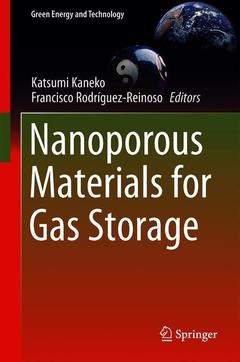Nanoporous Materials for Gas Storage, 1st ed. 2019 Green Energy and Technology Series

This book shows the promising future and essential issues on the storage of the supercritical gases, including hydrogen, methane and carbon dioxide, by adsorption with controlling the gas-solid interaction by use of designed nanoporous materials. It explains the reason why the storage of these gases with adsorption is difficult from the fundamentals in terms of gas-solid interaction. It consists of 14 chapters which describe fundamentals, application, key nanoporous materials (nanoporous carbon, metal organic frame works, zeolites) and their storage performance for hydrogen, methane, and carbon dioxide.
Thus, this book appeals to a wide readership of the academic and industrial researchers and it can also be used in the classroom for graduate students focusing on clean energy technology, green chemistry, energy conversion and storage, chemical engineering, nanomaterials science and technology, surface and interface science, adsorption science and technology, carbon science and technology, metal organic framework science, zeolite science, nanoporous materials science, nanotechnology, environmental protection, and gas sensors.
Francisco Rodríguez-Reinoso obtained his doctorate from Granada University (Spain) in 1967. He did postdoctoral research at Bristol University (UK) and Pennsylvania State University (USA) from 1968 to 1971. He was then Associate professor of Inorganic Chemistry at Granada Univ
Combines molecular level knowledge with material design for gas storage
Explains the reason why storage of hydrogen, methane, and carbon dioxide is difficult
Challenges the design and search of optimum porous materials
Pioneers industrial application route for natural gas storage by porous carbons
Date de parution : 05-2019
Ouvrage de 403 p.
15.5x23.5 cm
Disponible chez l'éditeur (délai d'approvisionnement : 15 jours).
Prix indicatif 158,24 €
Ajouter au panier